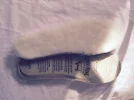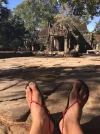I walked
Camino Frances 5 years ago, now going to start Via de la Plata 17th of March and here is the technique I used and going to use again:
Had few pairs synthetic high quality socks. While walking I would sit down every few hours to take shoes off and either let socks to completely dry out or take another pair. Now there's a need of preferably ice-cold water to put feet into for as long as you can handle. As I walked the most popular way, there was no problem having cold water anywhere really, sometimes I would just step into a spring or a river to chill feet down for a couple of minutes, few times it happened I still had to go for more than 10km, feet were hot, wet and tired and I had little water left to drink. Instead of drinking I took a plastic bag, poured water in and then feet in, just to chill them a bit, clean, and let completely dry out. The word "completely" is essential here. Oh and if the only water you've got is warm one, just clean the feet and let them dry.
So that's basically it. In the beginning I was probably stopping way too often, but in just a week I started feeling my feet very well, so that would usually be 2 decent 30min-1h30min stops a day to rest feet, body, eat, and anything else.
Now once you start feeling even some rubbing, take shoes off, chill, clean, wait, then tape the rubbing place, wrap bandage around your foot if you feel that plaster might go off, and should be fine until the end of the day, then carefully observing the place which felt rubbing in the morning and either apply plaster for another day, possibly making one or few additional stops to chill the feet.
So in general what matters the most is dry and cool feet (naturally assuming that shoes isn't the greatest trouble maker here). Following these simple guidelines, passed to me from some experienced travelers, I didn't have a single blister all the way from St Jean Pied de Port to Fisterra. And yes, I had blisters while preparing for CF with the same shoes, so I'm convinced the technique did miracles

Hope that helps!






















